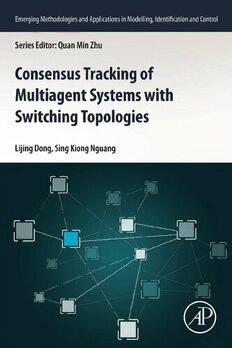
Consensus Tracking of Multi-agent Systems with Switching Topologies (Emerging Methodologies and Applications in Modelling, Identification and Control) PDF
Preview Consensus Tracking of Multi-agent Systems with Switching Topologies (Emerging Methodologies and Applications in Modelling, Identification and Control)
Consensus Tracking of Multiagent Systems with Switching Topologies Consensus Tracking of Multiagent Systems with Switching Topologies Lijing Dong Schoolof Mechanical,Electronic and Control Engineering, Beijing Jiaotong University, Beijing, P.R. China Sing Kiong Nguang Department ofElectrical,Computer,and Software Engineering, University of Auckland, Auckland, New Zealand AcademicPressisanimprintofElsevier 125LondonWall,LondonEC2Y5AS,UnitedKingdom 525BStreet,Suite1650,SanDiego,CA92101,UnitedStates 50HampshireStreet,5thFloor,Cambridge,MA02139,UnitedStates TheBoulevard,LangfordLane,Kidlington,OxfordOX51GB,UnitedKingdom Copyright©2020ElsevierInc.Allrightsreserved. Nopartofthispublicationmaybereproducedortransmittedinanyformorbyanymeans,electronic ormechanical,includingphotocopying,recording,oranyinformationstorageandretrievalsystem, withoutpermissioninwritingfromthepublisher.Detailsonhowtoseekpermission,further informationaboutthePublisher’spermissionspoliciesandourarrangementswithorganizationssuch astheCopyrightClearanceCenterandtheCopyrightLicensingAgency,canbefoundatourwebsite: www.elsevier.com/permissions. Thisbookandtheindividualcontributionscontainedinitareprotectedundercopyrightbythe Publisher(otherthanasmaybenotedherein). Notices Knowledgeandbestpracticeinthisfieldareconstantlychanging.Asnewresearchandexperience broadenourunderstanding,changesinresearchmethods,professionalpractices,ormedical treatmentmaybecomenecessary. Practitionersandresearchersmustalwaysrelyontheirownexperienceandknowledgeinevaluating andusinganyinformation,methods,compounds,orexperimentsdescribedherein.Inusingsuch informationormethodstheyshouldbemindfuloftheirownsafetyandthesafetyofothers,including partiesforwhomtheyhaveaprofessionalresponsibility. Tothefullestextentofthelaw,neitherthePublishernortheauthors,contributors,oreditors,assume anyliabilityforanyinjuryand/ordamagetopersonsorpropertyasamatterofproductsliability, negligenceorotherwise,orfromanyuseoroperationofanymethods,products,instructions,orideas containedinthematerialherein. BritishLibraryCataloguing-in-PublicationData AcataloguerecordforthisbookisavailablefromtheBritishLibrary LibraryofCongressCataloging-in-PublicationData AcatalogrecordforthisbookisavailablefromtheLibraryofCongress ISBN:978-0-12-818365-6 ForInformationonallAcademicPresspublications visitourwebsiteathttps://www.elsevier.com/books-and-journals Publisher:MatthewDeans AcquisitionsEditor:BrainGuerin EditorialProjectManager:JoshuaMearns ProductionProjectManager:R.VijayBharath CoverDesigner:VictoriaPearson TypesetbyMPSLimited,Chennai,India Contents Abouttheauthors ix Acknowledgment xi 1. Introduction 1 1.1 Abriefofmultiagentsystems 2 1.1.1 Relatedgraphtheory 4 1.1.2 Consensuscontrol 5 1.1.3 Formationcontrol 6 1.1.4 Consensustracking 8 1.2 Multiagentsystemswithtime-varyingtopologies 10 1.2.1 Multiagentsystemswithswitchingtopologies 10 1.2.2 Multiagentsystemswithjointlyconnectedtopologies 11 1.2.3 Multiagentsystemswithcontinuouslytime-varying topologies 13 1.3 Multiagentsystemswithnodefailures/actuatorfaults 14 1.4 Applicationsofmultiagentsystems 17 1.4.1 Applicationtocooperativerobots 17 1.4.2 Applicationtomulti-unmannedaerialvehicle 18 1.4.3 Applicationtointelligenttraincontrol 19 References 20 Furtherreading 27 2. Multiagent systems with continuously switching topologies 29 2.1 Introduction 29 2.2 First-ordermultiagentsystemswithcontinuouslyswitching topologies 30 2.2.1 Mainresults 30 2.2.2 Anumericalexample 34 2.3 Second-ordermultiagentsystemswithcontinuouslyswitching topologies 36 2.3.1 Consensustrackingwithdouble-integratordynamics 37 2.3.2 Consensustrackingwithsecond-ordernonlineardynamics 40 2.3.3 Numericalexamples 42 2.4 Conclusion 45 References 46 v vi Contents 3. High-order multiagent systems with continuously switching topologies 47 3.1 Introduction 47 3.2 Problemdescription 48 3.3 High-ordermultiagentsystemswithcontinuouslyswitching topologies 49 3.3.1 Stabilityanalysis 50 3.3.2 Simulationresults 53 3.4 High-ordermultiagentsystemswithcontinuouslyswitching topologiesbasedonpolytopicmodel 54 3.4.1 Stabilityanalysis 56 3.4.2 Anumericalexample 58 3.5 Conclusion 63 References 64 4. High-order multiagent systems with time delays and continuously switching topologies based on polytopic model 65 4.1 Introduction 65 4.2 Problemdescription 66 4.3 Mainsection 67 4.4 Numericalexamples 73 4.5 Conclusion 85 References 85 5. Sliding mode control for multiagent systems with continuously switching topologies based on polytopic model 87 5.1 Introduction 88 5.2 Preliminariesandproblemdescription 89 5.3 Slidingmodecontrollerdesignandstabilityanalysis 89 5.3.1 Slidingmodecontrollerdesign 89 5.3.2 Stabilityanalysis 91 5.3.3 Numericalexamples 94 5.4 Slidingmodecontrolformultiagentsystemswithdisturbances 98 5.4.1 Slidingmodecontrollerdesignforsystemswith disturbances 98 5.4.2 Stabilityanalysisforsystemswithdisturbances 99 5.4.3 Numericalexamples 102 5.5 Conclusion 102 References 105 Contents vii 6. Cooperative relay tracking strategy for multiagent systems with assistance of Voronoi diagrams 107 6.1 Introduction 107 6.2 Voronoidiagrams 109 6.3 Relaytrackingalgorithm 113 6.4 Controllerdesignandstabilityanalysis 115 6.5 Numericalexamples 120 6.6 Conclusion 127 References 128 Furtherreading 129 7. Stability of a class of multiagent relay tracking systems with unstable subsystems 131 7.1 Introduction 131 7.2 Relatedpreliminaries 132 7.3 Problemformulation 134 7.4 Controllerdesignandstabilityanalysis 136 7.5 Disturbanceattenuationanalysis 139 7.6 Numericalexamples 141 7.7 Conclusion 149 References 149 8. Multiagent relay tracking systems with damaged agents and time-varying number of agents 151 8.1 Introduction 151 8.2 Relaytrackingsystemswithdamagedagents 152 8.2.1 Problemformulation 153 8.2.2 Relaytrackingalgorithm 154 8.2.3 Controllerdesignandstabilityanalysis 155 8.2.4 Anumericalsimulation 161 8.3 Relaytrackingsystemswithtime-varyingnumberofagents 163 8.3.1 Preliminariesandproblemformulation 164 8.3.2 Mainresultsofrelaytrackingsystemswithtime-varying numberofagents 168 8.3.3 Anumericalsimulation 171 8.4 Conclusion 172 References 174 9. Multiagent relay tracking systems with time-varying number of agents and time delays 177 9.1 Introduction 177 9.2 Linearrelaytrackingsystemswithtime-varyingnumberof agentsandtimedelays 178 viii Contents 9.2.1 Problemformulation 178 9.2.2 Mainresults 181 9.2.3 Numericalsimulations 189 9.3 Nonlinearrelaytrackingsystemswithtime-varying numberofagentsandtimedelays 192 9.3.1 Relatedpreliminaries 192 9.3.2 Stabilityanalysis 195 9.3.3 Numericalsimulations 200 9.4 Conclusionanddiscussions 204 References 206 10. Finite time stability analysis and coordination strategies of multiagent relay tracking systems 207 10.1 Introduction 208 10.1.1 Finitetimeboundedness 208 10.1.2 Finitetimecoordinationrelaystrategies 209 10.2 Stabilityanalysisofnonlinearmultiagentrelaytracking systemsoverafinitetimeinterval 209 10.2.1 Relaytrackingproblemformulation 209 10.2.2 Stabilityanalysisoverafinitetimeinterval 212 10.2.3 Stabilityanalysisforsystemssubjecttodisturbances 214 10.2.4 Numericalexamples 215 10.3 Finite-timecoordinationcontrolofmultiagentsystemsfor targettrackingwithnodefailuresandactivereplacements 218 10.3.1 Trackingproblemdescriptionandfundamentals 220 10.3.2 Event-triggeredcoordinationstrategy 222 10.3.3 Nonsingularterminalslidingmodecontrollerdesign 224 10.3.4 Finitetimeanalysiswithmodifiedslidingmodecontrol 226 10.3.5 Stabilityanalysisofsystemswithagentreplacements 228 10.3.6 Numericalsimulations 229 10.4 Conclusion 235 References 235 Furtherreading 237 11. Conclusions and future research 239 11.1 Conclusions 239 11.1.1 Consensustrackingcontrolofsystemswith continuouslyswitchingtopologies 239 11.1.2 Relaytrackingcontrolofsystemswithagent replacements 240 11.2 Futureresearch 240 11.2.1 Generalnonlinearmultiagentsystems 241 11.2.2 Cooperativecontrolalgorithmsbasedondeeplearning 241 References 241 AppendixA 243 Index 249 About the authors LijingDong Lijing Dong received the BE and the PhD degree from the School of Automation, Beijing Institute of Technology, Beijing, China, in 2010 and 2016, respectively. From 2013 to 2014, she was a visiting scholar with the Department of Electrical and Computer Engineering, University of Auckland. Currently, she is an Associate Professor at School of Mechanical, Electronic and Control Engineering, Beijing Jiaotong University. Her current research interests include multiagent systems and distributed control systems. She has obtained the authorization of multiple invention patents. In 2016 she got the first prizes of science and technology award from China Railway Society and innovation achievement award from China Industry-University- Research Institute Collaboration Association. She has published more than 20 refereed journal and conference papers on multiagent systems and large- scale complex systems and has/had served as reviewer of a number of inter- nationaljournals. Sing Kiong Nguang Sing Kiong Nguang received the BE (with first class honors) and the PhD degree from the Department of Electrical and Computer Engineering of the University of Newcastle, Callaghan, Australia, in 1992 and 1995, respec- tively. Currently, he is a Chair Professor at the Department of Electrical, Computer, and Software Engineering, University of Auckland, Auckland, New Zealand. He has published more than 300 refereed journal and confer- ence papers on nonlinear control design, nonlinear control systems, nonlinear time-delay systems, nonlinear sampled-data systems, biomedical systems modeling, fuzzy modeling and control, biological systems modeling and con- trol, and food and bioproduct processing. He has/had served on the editorial board of a number of international journals. He is the chief editor of the InternationalJournalofSensors,Wireless Communications and Control. ix Acknowledgment We gratefully acknowledge the support from the National Natural Science Foundation of China under Grant 61903022. xi
